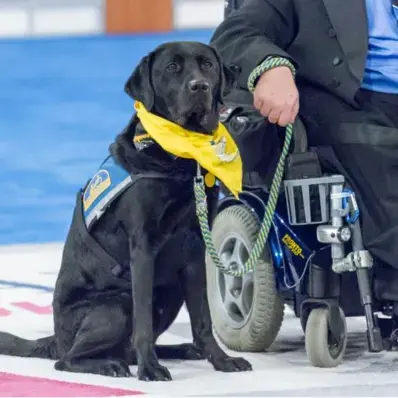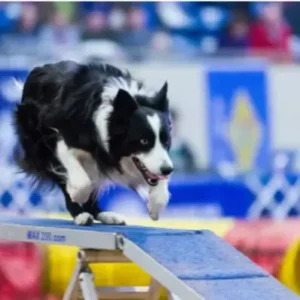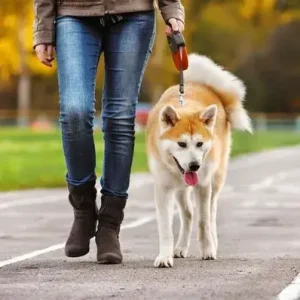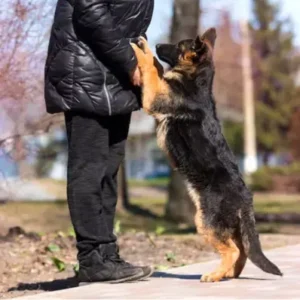Types of Disabilities Service Dogs Assist With
Service dogs can be trained to assist with various disabilities:
- Mobility Impairments: Dogs provide mobility assistance for physical disabilities, such as opening doors, carrying items, or assisting with balance.
- Hearing Impairments: Dogs that alert individuals to important sounds like doorbells, alarms, or approaching vehicles.
- Psychiatric Disabilities: Dogs that provide psychiatric service, emotional support, and alert to triggers for anxiety, PTSD, or other mental health conditions.
Steps for Training a Service Dog
To begin the training process, it’s essential to start with foundational skills that will serve as the building blocks for more advanced tasks.
Here are the essential steps to follow for training your service dog:
Step# 1- Determine if Your Dog Can Be a Service Dog
Before beginning the demanding process of training a service dog, evaluate if your dog is fit for the role. Consider these questions:
- How old is the dog?
The dog should be over six months old and spayed/neutered. Older dogs with health issues like arthritis or diabetes may struggle with training. - What’s the dog’s temperament?
Service dogs need a calm, composed demeanor. They shouldn’t be aggressive toward other dogs but must remain alert when needed. - How is the dog’s attention span?
The dog should focus well during training and avoid distractions, especially in public settings where safety could be at risk. - What limitations does the dog have?
Physical or mental limitations may affect its ability to assist. For example, larger dogs are better suited for balance assistance than smaller breeds.
The best service dogs are calm, confident, intelligent, healthy, and responsive to commands. Breed isn’t a limiting factor—any dog meeting these criteria can be trained. If your dog doesn’t fit, consider getting a professionally trained service dog.
Step# 2- Starting with Basic Obedience Training
Before a dog can be trained for specific service tasks, it must first have a strong foundation in basic obedience. These are the building blocks for everything that comes next.
Essential Commands
Start by teaching your dog basic commands:
- Sit: A foundation for calmness and control.
- Stay: Teach your dog to remain in a specific position until released.
- Come: A crucial command for recall in any situation.
- Down: Teach your dog to lie down calmly.
- Heel: Helps the dog stay by your side during walks.
Socialization
Service dogs must be well-socialized. Expose them to different environments, people, and other animals. They should be comfortable around distractions and remain calm in busy or unpredictable settings, as they’ll need to function in public spaces.
Housebreaking and Crate Training
Crate training a dog ensures that the dog has a safe, private space to relax. It also helps with housebreaking, encouraging the dog to hold its bladder indoors. A well-trained service dog must have proper house manners and be calm in the home environment.
Step# 3- Specialized Task Training
Once your dog has mastered basic obedience, it’s time to begin training for specific tasks. This training of your dog will be tailored to the individual’s needs, depending on the disability.
Identifying Tasks
Each service dog is trained to perform tasks that directly assist their handler. Some examples of tasks include:
- Retrieving items: Helping with dropped objects or fetching specific items like medication or a phone.
- Seizure Alert: Some dogs are trained to alert their owners to an impending seizure, giving them time to react.
- Guiding: Dogs trained to assist those with visual impairments by leading them through environments.
- Calming behaviors: Dogs are trained to sense when their handler is experiencing a mental health crisis and provide calming actions, such as applying pressure or retrieving a comfort item.
Training Techniques for Tasks
Task training requires patience and repetition. Use positive reinforcement, such as treats or praise, when the dog successfully performs a task. The key is to break down each task into smaller steps, allowing the dog to master each stage before progressing to more complex tasks.
Step# 4- Public Access Training
Service dogs need to be well-behaved in public settings, as they will accompany their handler in various environments like stores, restaurants, and airports.
Proper Public Behavior
Service dogs must not distract others or engage in undesirable behaviors, such as barking, jumping on people, or becoming agitated in crowds. Teach your dog to ignore distractions and maintain focus on you, ensuring they can assist without causing disruptions.
Exposure to Various Environments
Expose your dog to different settings, including places with noise, crowds, and unfamiliar smells. This helps the dog learn how to behave calmly and confidently in any situation, from public transportation to busy shopping centers.
Step# 5- Certification and Legal Considerations
While there is no official certification required in most places, some organizations offer voluntary certification programs to help ensure your dog meets the necessary standards for public access.
Service Dog Laws and Rights
In the U.S., service dogs are protected under the Americans with Disabilities Act (ADA). This law ensures that individuals with disabilities can bring their service dogs into public places and that their dogs are trained to behave appropriately in these environments.
When is the Dog Ready for Public Access?
Your dog will be ready for public access when it can consistently perform its tasks, follow basic commands, and behave appropriately in public spaces. Be sure to thoroughly evaluate their behavior and readiness before taking them out into the public.
Step# 6- Ongoing Training and Maintenance
Training doesn’t end once a service dog is ready to assist. Ongoing maintenance and periodic refresher courses are necessary to keep the dog sharp and prepared for new situations.
Continuous Reinforcement
Even after initial training, service dogs need reinforcement. Regular practice ensures that the dog remains proficient at tasks and maintains good behavior.
Adjusting to Changing Needs
As the handler’s needs change, the dog’s training may need to be updated or adjusted. A service dog’s training is an ongoing process, requiring flexibility and adaptability from both the dog and handler.
Examples of Service Dog Breeds
Certain breeds are often preferred for service work due to their temperament, intelligence, and physical capabilities.
- Labrador Retriever: Friendly, adaptable, and highly trainable; great for guiding, mobility, and medical alert tasks.
- Golden Retriever: Gentle and eager to learn, ideal for various roles like mobility and psychiatric assistance.
- German Shepherd: Loyal and intelligent, commonly used as a guide, hearing, and mobility assistance dogs.
- Standard Poodle: Hypoallergenic and smart, often trained for medical alert tasks.
- Border Collie: Energetic and quick-thinking, suited for tasks needing precision and agility.
- Boxer: Strong yet gentle, great for mobility support and psychiatric tasks.
- Great Danes: Large and sturdy, perfect for balance assistance roles.
While these breeds are popular, any dog with the right temperament and health can become a service dog.








